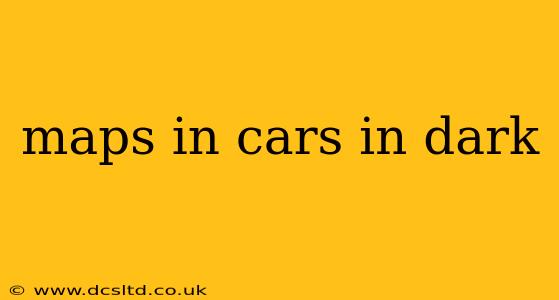Driving at night presents unique challenges, and relying on a car's navigation system becomes even more critical in low-light conditions. While most modern car navigation systems function well in the dark, understanding their capabilities and limitations can enhance safety and improve your nighttime driving experience. This article explores how car maps function in darkness, addressing common concerns and providing practical tips.
How Do Car Navigation Systems Work in the Dark?
Car navigation systems primarily utilize GPS (Global Positioning System) technology, unaffected by darkness. The GPS satellites transmit signals regardless of the time of day, providing continuous location data to your vehicle. The map displayed on your screen remains visible, adapted to the low-light conditions through adjustable screen brightness. Many systems also feature night modes that reduce screen glare and enhance readability.
Are Car Maps Accurate at Night?
The accuracy of a car map is largely independent of the time of day. GPS accuracy relies on the satellite signals, which aren't affected by light levels. However, factors like atmospheric conditions (e.g., heavy rain or fog) or obstructions (e.g., tall buildings in urban areas) can impact GPS signal strength, potentially affecting accuracy slightly, regardless of whether it's day or night.
Can I Use My Phone's Maps App in the Car at Night?
Yes, you can use your phone's maps app at night, but with caveats. Ensure your phone is securely mounted to avoid distractions and that the screen's brightness is appropriately adjusted to minimize glare. Driving with a phone in your hand is illegal in most jurisdictions, and extremely dangerous. Hands-free options are a much safer alternative, although even those need to be used cautiously, maintaining awareness of the road.
What Happens if My Car's Navigation System Fails at Night?
If your car's navigation system malfunctions, having a backup plan is crucial. Consider keeping a physical map, especially for unfamiliar routes or areas with limited cell service. A reliable offline maps app on your phone, downloaded in advance, is also a good backup. Remember to charge your phone fully before embarking on nighttime drives.
How Can I Improve the Visibility of My Car's Navigation Screen at Night?
Most modern navigation systems allow you to adjust screen brightness and contrast. Experiment with these settings to find an optimal level that is both easily readable and avoids causing glare. Many also offer customizable night modes, specifically designed to reduce eye strain and enhance visibility in low-light conditions. Avoid overly bright settings that could be distracting.
Does Night Driving Affect GPS Accuracy?
No, night driving itself doesn't directly affect GPS accuracy. The GPS signal reception is independent of light levels. However, reduced visibility due to darkness might indirectly impact your ability to follow the navigation instructions precisely, leading to minor deviations from the planned route.
What Are the Best Practices for Using Car Navigation at Night?
- Plan your route in advance: Knowing your route beforehand reduces the need for on-the-fly navigation adjustments in low-light conditions.
- Adjust screen brightness: Find the optimal brightness setting that's easy to read but doesn't cause glare.
- Use night mode: If your navigation system offers a night mode, activate it.
- Stay focused on the road: Never take your eyes off the road for extended periods to consult your navigation system.
- Have a backup plan: Always have a physical map or offline maps app as a backup.
By understanding how your car's navigation system works in darkness and employing these best practices, you can navigate safely and confidently at night. Remember, responsible nighttime driving always prioritizes safety and awareness.
